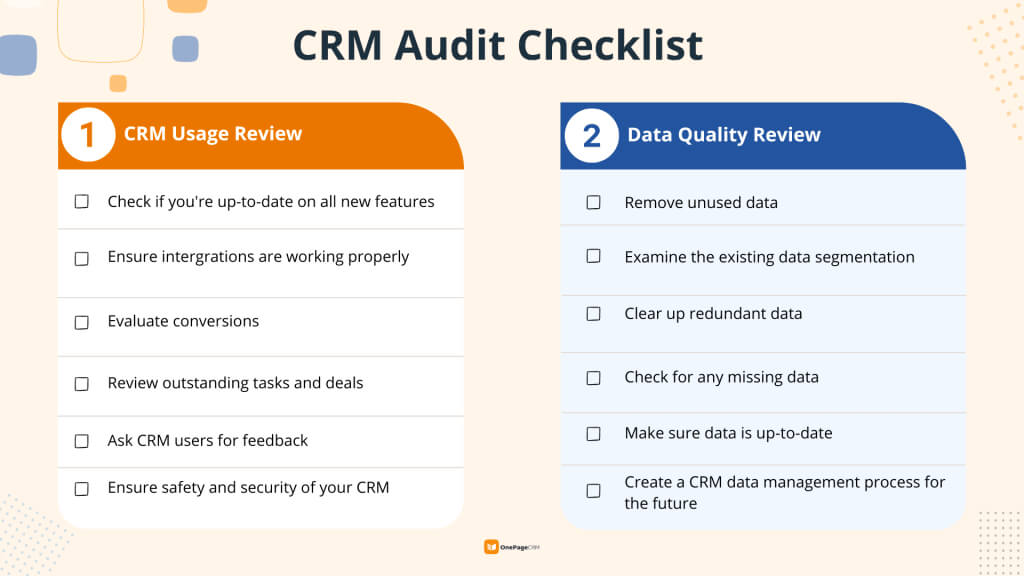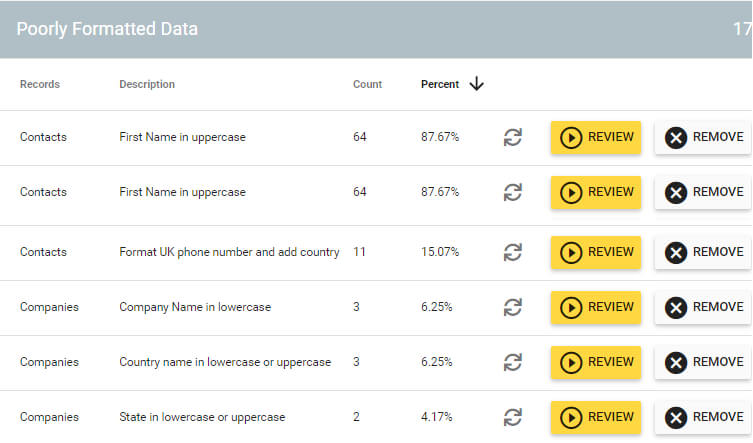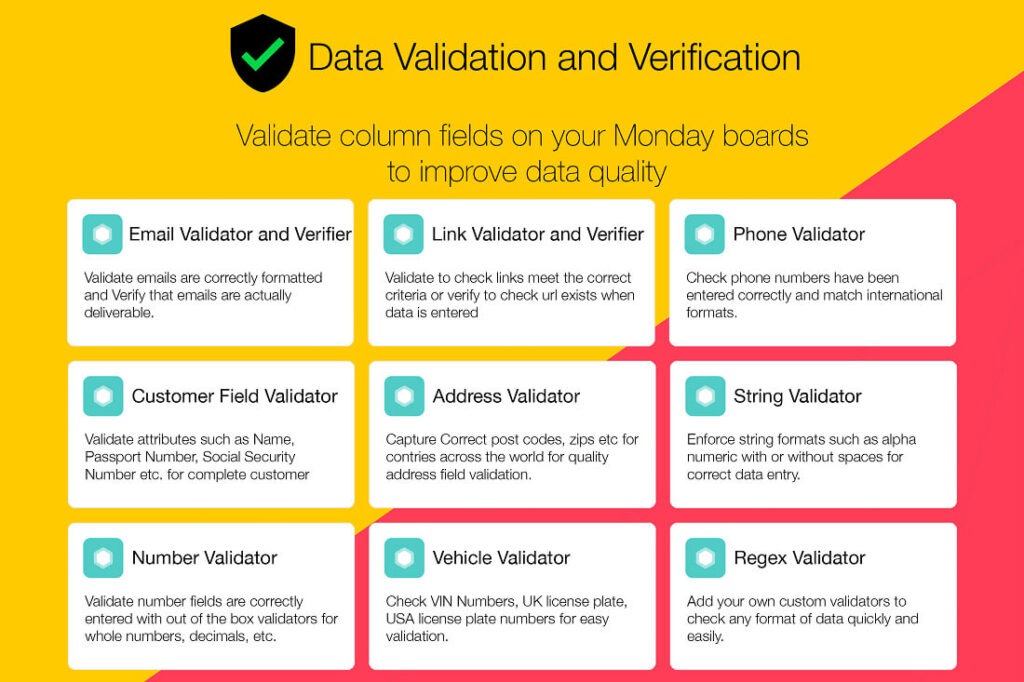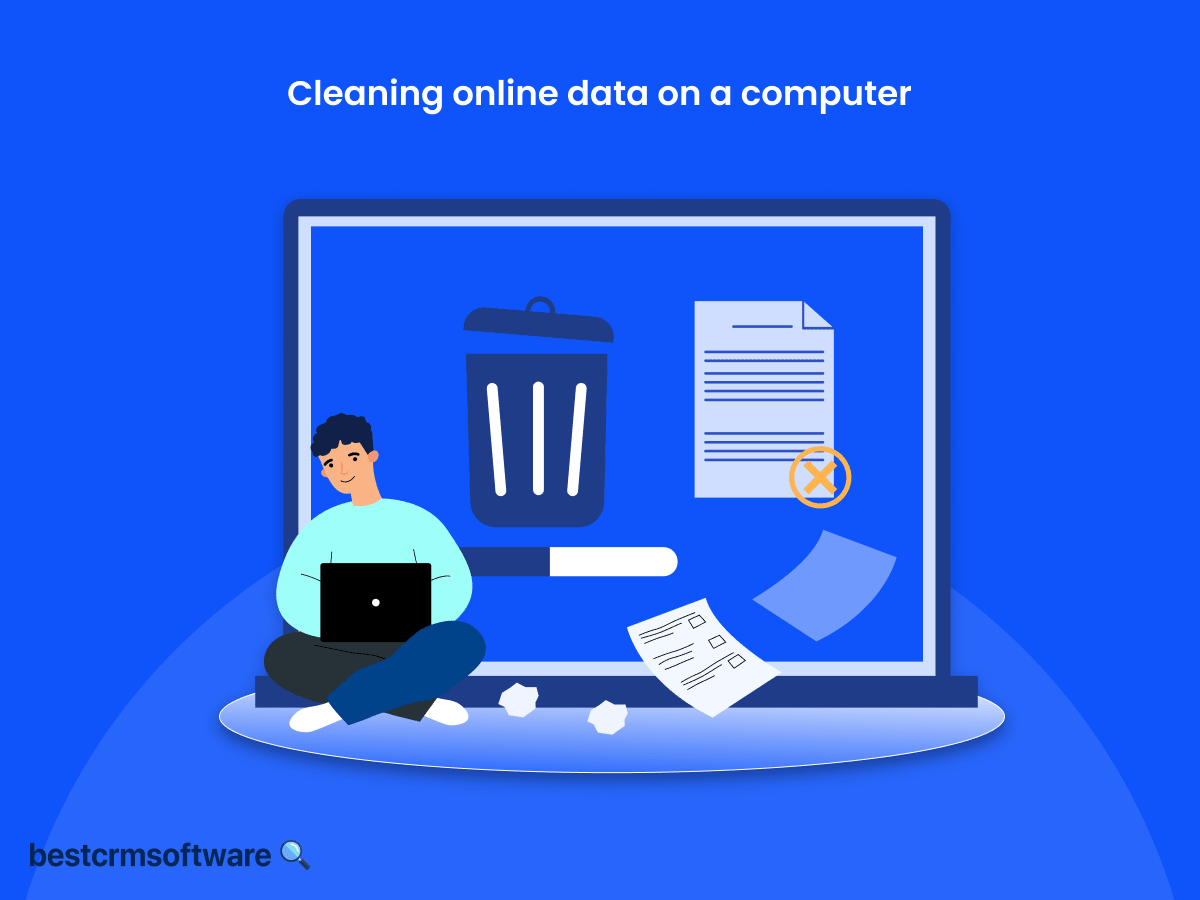
CRM Data Cleansing – How to Clean up a CRM Database
A CRM (Customer Relationship Management) system manages business relationships and stores critical customer data like interactions and transactions. Therefore, it can also be called the backbone of a business.
However, as data accumulates in a CRM system, so do inaccuracies, duplications, and inconsistencies.
This is where CRM data cleansing becomes indispensable and urgent. It involves identifying, correcting, and removing erroneous, incomplete, or redundant data within the CRM database.
When you follow through with the process, you can:
- Ensure data integrity
- Improve customer experience
- Streamline business operations
In this blog, we’ll go through the process of CRM data cleaning in some simple steps to keep your business running smoothly.
Let’s get started!
Step 1: Perform Data Audits to Identify Errors Periodically
Data auditing is the first step in cleaning up your CRM database. Here’s how to effectively perform regular data audits:
1. Assess the Overall State of Your Data
Begin by evaluating the current state of your CRM database and check if the data is relevant and up-to-date. Determine what information is reliable and what needs to be corrected or removed permanently.
2. Identify the Source of Errors

While human error is common, other factors like system glitches or inconsistent data entry processes can also contribute to data inaccuracies. So, ensure to discover the root causes of incorrect data to prevent them from happening again or reduce occurrences.
3. Establish a Regular Audit Schedule

For many companies, setting an annual data audit schedule can help maintain consistency and ensure timely detection of errors. This helps not only minimize interruptions in everyday work processes but also keeps data quality in check.
4. Leverage Automated Tools
Consider using an integrated platform that leverages automation to streamline the data auditing process. Such tools can help you identify patterns in erroneous data, reveal how errors occurred, and implement preventive measures.
Step 2: Remove Duplicate or Irrelevant Data Entries
Removing duplicate or irrelevant data entries is a crucial step in CRM data cleanup. Cases of data duplication can often occur during data collection, for instance, when you’re integrating data sets from multiple sources or receiving data from various departments or clients.
What Is the Impact of Irrelevant and Duplicate Data Entries?
Irrelevant or duplicate data entries pose significant challenges. They not only lead to wasted resources and decreased productivity but also complicate reporting and analytics, making it difficult for teams to derive actionable insights.
When teams update different entries for the same record, it can sometimes become challenging to determine which information is correct and up-to-date.

Hence, consolidating duplicate records and examining irrelevant entries is essential for streamlining operations and ensuring data consistency across the organization.
What Data Cleansing Strategies Are Needed to Be Implemented?
To resolve issues concerning duplicate or irrelevant data entries effectively, you may manually review them (which could be time-consuming) or use tools to asses them with automation.
Using either or both strategies will help you save time, improve data accuracy, and enhance overall productivity.
Step 3: Streamline Data to Lower Costs and Reduce Clutter
As companies accumulate vast amounts of data over time, a portion of it becomes outdated or irrelevant. Keeping unnecessary data in your CRM database not only hampers efficiency but also adds unnecessary costs. Here are some ways to declutter your database effectively:
1. Eliminate Inactive Contacts
When you remove data of inactive contacts, you free up space and enhance the effectiveness of your marketing efforts.
Contacts that haven’t engaged with your materials for an extended period are likely outdated or uninterested. Establish a policy for removing disengaged contacts to prevent database bloat and ensure data relevancy.
2. Filter Out Free Email Domain Contacts

While some subscribers legitimately use free email addresses, a portion of them may be spam or irrelevant leads. Use analytics to differentiate between engaged leads and potential spam accounts.
By filtering out irrelevant contacts, you can optimize resource allocation and marketing efforts that focus on genuine prospects.
Step 4: Address Case and Formatting Issues

Formatting and case inconsistencies are common pitfalls in any dataset, often arising from manual data entry or data collection from multiple sources.
Resolving these issues is essential for ensuring data accuracy and professionalism. Here are some formatting and case issues that require effective correction:
1. Validate Email Address Formatting
Address common issues like missing or extra characters, typos, and whitespace to reduce the likelihood of bounce-backs and delivery issues. Properly formatted email addresses are crucial for successful communication. This will also help you maintain your company’s credibility with email providers.
2. Optimize Mailing Address Formatting
Avoid wastage of resources by ensuring effective address formatting, including complete zip codes and appropriate formatting conventions. Correctly formatted addresses are crucial for efficient mail delivery and support cost-saving measures.
3. Format Phone Numbers in a Standardized Manner
Verify if numbers are 10 or 11 digits long, have the correct prefixes and separators, and consider variations like office, mobile, or home phone numbers. This ensures compatibility with various systems and streamlines communication processes with customers and prospects.
4. Fix Proper Case for First and Last Contact Names
Correcting the capitalization of contact names may seem minor, but it greatly impacts professionalism and reflects positively on your brand. For example, addressing someone as “Diana Jones” rather than “diana jones” portrays professionalism and increases conversion rates.
Step 5: Address Missing Data

Dealing with missing data is a crucial part of data cleaning, as many algorithms cannot handle null values. Here are three approaches to handle missing data, each with its own considerations:
1. Dropping Observations with Missing Values
One option is to remove observations with missing values entirely. While this simplifies the dataset, it comes at the cost of losing potential information that could be of some value. So, carefully weigh the impact of data loss before implementing this approach.
2. Inputting Missing Values
Another approach is to input missing values based on other observations of the entire data. However, this method may compromise data integrity as it relies on assumptions to carry out the task.
Hence, exercise caution while doing this to ensure the reliability of the resulting dataset and avoid inaccuracies.
3. Adapting Data Usage to Handle Null Values
Alternatively, you can adapt how data is used to navigate null values effectively. This approach involves adjusting algorithms or analysis techniques to accommodate missing data without compromising the overall integrity of the analysis.
As you can see, each approach has its own benefits and drawbacks. But the most suitable method depends on your specific dataset, analysis, and data cleaning requirements.
Step 6: Validate Data

When you ensure that your data is relevant and up-to-date, it improves your decision-making process. Remember that validating information is a crucial part of your data-cleaning process. Here’s how to go about it:
1. Implement Checks for Correct Data Entry
Start by implementing checks to ensure data is entered correctly into your system. This includes verifying that all required fields are filled and that data formats are consistent throughout.
2. Perform Periodic Validation Checks
Contacts may change their addresses, phone numbers, email addresses, or any other details of their personal or professional life. So, conduct periodic checks to validate the ongoing authenticity of your data.
You must also reach out to contacts to confirm the validity of their details. It’s quite an important part of the data-cleaning process as it not only helps validate data but also lets you improve connections with your customers and vendors.
3. Evaluate Data Quality
Once you are done fulfilling these steps of the data cleansing process, it’s time to assess the quality of your data. You may address some critical concerns:
- Ensure that the data makes sense and aligns with your expectations
- Verify if the data complies with the appropriate rules and standards for its field.
- Assess whether the data provides any valuable insights that can inform decision-making
- Look for observable trends in the data that may impact future business strategies or decisions
Remember, erroneous or incomplete data can lead to misguided or false conclusions, ultimately jeopardizing your business strategies and decision-making. So, build a data quality culture within your organization by leveraging automation tools and establishing best practices for maintaining data integrity.
Expert Tips for CRM Data Cleansing and Optimization
The importance of following the best practices, tips and tricks for CRM data cleaning management cannot be overstated. Here are some expert tips that you may adopt to improve the data cleansing process:
- Create a Maintenance Schedule: Setting up regular audits to keep your database error-free and up-to-date is crucial. Establish a clear data cleaning strategy to simplify maintenance tasks and ensure data accuracy.
- Leverage Automation for Efficiency: Using automation tools to streamline repetitive tasks can help you save time by minimizing manual efforts. Set up automated reminders for regular data reviews and reduce the risk of data errors in data management.
- Use Data Reports: Leveraging advanced reporting tools can help you identify gaps in data management, track engagement, and optimize email campaigns.
- Implement Standardized Data Entry: Establishing standardized data entry protocols is crucial for creating reliable data and facilitating effective data analysis.
- Delete Unnecessary Data: Decluttering your CRM by removing obsolete records and unresponsive contacts allows for more efficient use of resources.
- Offer Comprehensive CRM Training & Documentation: Providing comprehensive training and documentation is another critical factor that ensures all users understand CRM best practices. This will help employees reduce data errors and maximize CRM effectiveness.
Summing It Up
While there’s no one-size-fits-all template for cleaning up a CRM database, the steps discussed in this blog act as guidelines for businesses seeking to enhance data quality and efficiency and help them make their database updated and error-free.
Additionally, go for data cleansing tools to optimize manual tasks. It will save your time and effort and allow you to focus better on your business operations and goals.







